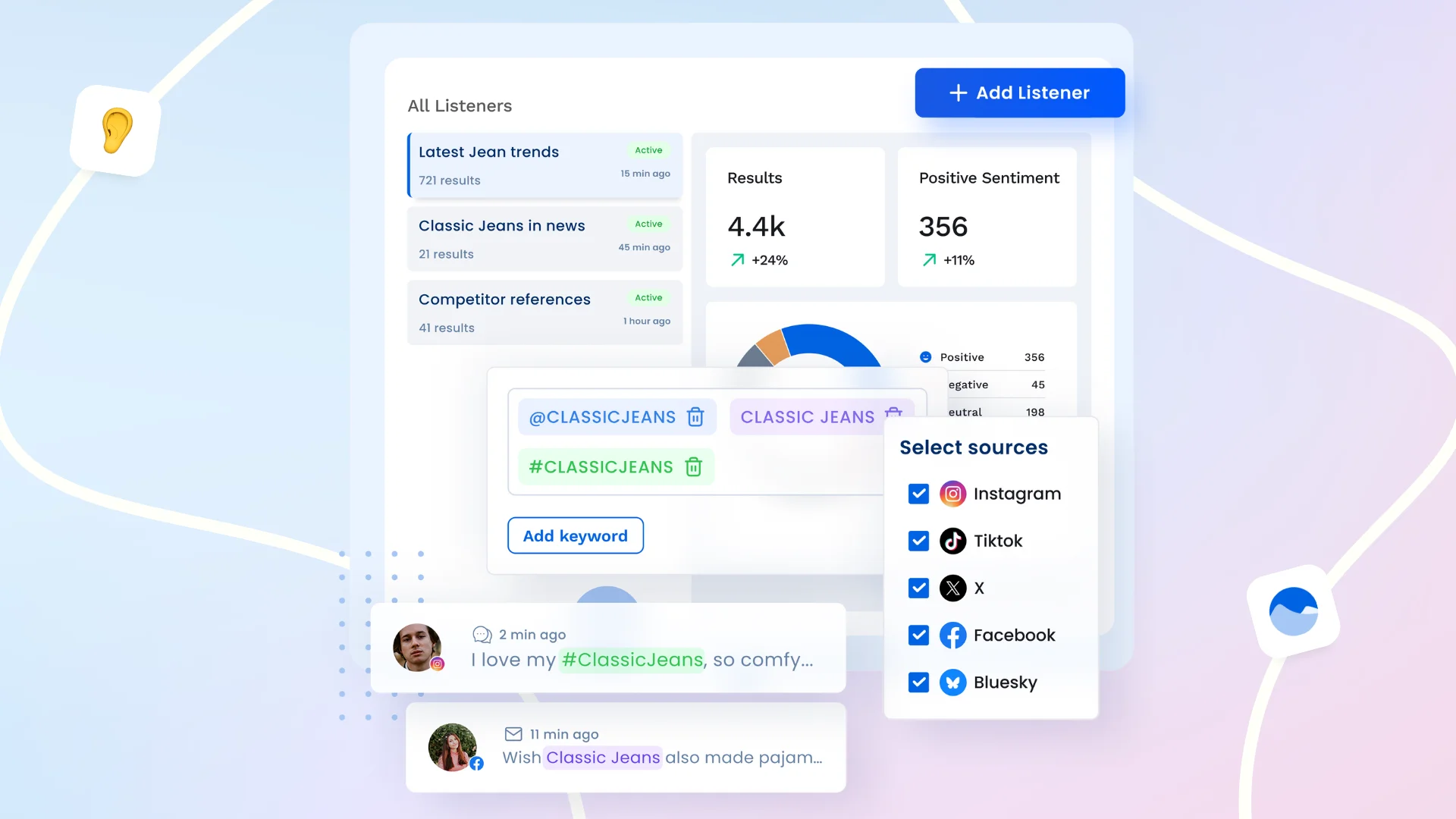New

Social Listening Made Simple: How to Use It for Brand Growth
Learn why social listening is no longer just for big brands and how Vista Social makes it affordable for creators, agencies, and small businesses.

How Something Social Saved 75% of Their Time and Increased Revenue by 15%
See how a fast-growing agency improved operations, cut down hours of manual work, and unlocked new revenue opportunities with Vista Social.
New

50 Unique Social Media Ideas for Consistent Content Creation
Discover 50 unique social media post ideas to engage your audience, grow your brand, and maintain a consistent content strategy with ease!
Mindful Social Media Practices That Will Make You a Happier Marketer
Updated on December 6, 2022
10 min to read
Content Writer
Published July 25, 2022


Content
Share

Creating mindful social media practices is key to your happiness as a marketer. Social networks can be a very dark place, and there is a lot of controversy on the implications of these apps on mental health. Since the algorithms are tailored towards posts with the most engagement, typically, content that fuels argumentative discussions appear more frequently on your feed.
Although your personal accounts may be crafted so that your newsfeed and explore section are filled with positivity, it can be more difficult to cultivate this on a brand’s social handles. And with cancel culture a very real thing in 2021, there is a chance for complete burnout with all of the internet’s stress, negativity, and trolls. Since a marketer’s job includes brand building, brand voice, and reputation management, staying positive and calm can become exceedingly tough.
Cultivating a few mindful social media practices and using a few efficient techniques should help marketers get their jobs done while remaining happier at the end of the day.
Table of contents
Why Are Social Media Sites Harmful For Overall Wellbeing?
Instagram is the worst social media network for mental health and wellbeing, according to a recent survey of almost 1,500 teens and young adults. While the photo-based platform got points for self-expression and self-identity, it was also associated with high levels of anxiety, depression, bullying, and FOMO, or the “fear of missing out.”
Now, typically when you hear this stat, you would assume that it is in regards to personal accounts and profiles. But, marketers can find themselves with these same emotions when taking a look at their competitor’s content. You can find yourself spending hours comparing content pieces and followers, which can spark up enormous amounts of anxiety.
On top of this, there is also cancel culture that marketers need to be wary of. In a recent survey conducted by Pew Research Centre, 58% of U.S. adults say in general, calling out others on social media is more likely to hold people accountable, while 38% say it is more likely to punish people who don’t deserve it. The fact of the matter is, you’re not going to make everyone happy, and there are going to be times where someone calls you (or your brand) out on social media.
Marketers are overly susceptible to feelings of missing out, validation, depression, and memory loss. Since their jobs demand high concentration times and extreme focus in rooting out the best ways for clients to connect with target audiences, they may lose sleep, get low self-esteem, and have unhealthy interpersonal relationships.
How To Overcome These Mental Health Risks?
Marketers need to keep refreshing themselves throughout the day. If you are a marketer handling multiple client accounts and dealing with social media, you should step away from the computer screen several times a day. Social media can be addictive!
As a marketer, you can feel as though there is a need to remain connected at all times to users, followers, and clients. This in itself can feel draining as you are in a constant state of worrying. Take a deep breath; you are human — not a robot.
This is why it’s key for marketers to develop a support system, whether it be through colleagues, friends, or marketing software, to keep everything running smoothly. Make more time to be present in the moment when you have the chance. If you’re going to grab a coffee, leave your phone. Focus on grounding through your senses while on your journey to the coffee shop — What does it smell like? What does it taste like? What do you hear? These are crucial for you to disconnect from anything stressful and create mindful social media practices.
Let us look at mindful social media practices that will make you a happier marketer in the long term. While these practices or tips are not fool-proof, they should help start you on the journey.
1. Get Started
Getting started is often one of the hardest things to do. It takes courage to identify factors that need redefining (personally). While the job roles and responsibilities don’t change, you would have to find your happiness and peace while doing the same job. After all, mental health and happiness only affect you internally.
2. Define the Goal For the Day
As a marketer, you may have pre-defined deliverables and milestones per week. Since social media is a never-ending space, it is best to have a few personal goals each day. These goals do not have to clash with your deliverables. Instead, they should enhance and add value to the pre-existing ones.
Start simple with one goal a day. Ask yourself, what would make today a great day? Is it finishing that blog post, increasing followers, driving site traffic? Whatever it is, make sure that you set a SMART goal for that day so that you aren’t as overwhelmed with everything you need to accomplish.

Each day can be a new challenge. While you are making these goals, you should remain mindful of your achievements throughout the day. Having a positive outcome to focus on will help take the stress away from all the intense negative emotions on social media. It will also allow you to become more effective and find happiness.
3. Stay Present and Focused
Although you may be knocking out all your tasks for that day, your mind can wander and think about everything that still needs to get done. While this may be a given, it is easy to get lost when tracking metrics or analyzing social media data. Link your focus with the deliverables and your personal goal. Doing this will help you increase efficiency in your job. Instead of focusing on the future, or past mistakes, it is necessary to take each day as it comes.
Mindfulness of the job needs some practice. However, if you constantly remind yourself to stay in the present, you will get better at your job, achieve goals faster, and become better each day. If you’ve made a mistake previously on a task and are worried about doing it again, take some time to write out affirmations around this fear.
Mindful Social Media Affirmations for Marketers:
- I am able to remain calm under potentially stressful circumstances and believe I deserve to reach my professional goals.
- I will quickly and successfully adapt to any new changes in my industry.
- I naturally think outside the box and find solutions.
- Working on multiple tasks is something I do with ease.
- I am a natural-born leader and happy to help others.
Improve the Feeds
Improving the feeds on social media is a nightmare. It is a tedious task filled with trollers, hate speech, nasty comments, and whatnot. There might also be veiled threats against the client in the guise of feedback.
For marketers, it is necessary to navigate through tonnes of negativity, criticism-based, and more. Improving the feeds is essential for the brand image and also to help improve your overall mood and outlook. If there are users or followers in your target audience who always post negative feedback and comments and tend to influence others to do the same, you need to take corrective steps.
With any negative comments, images, GIFs, and other forms of communication, it is necessary to project a positive attitude. Unfortunately, online communication on posts, blogs, and comments is only written. What this means is that others cannot see remorse, guilt, decisions, or more. It also means the absence of body language cues. When it is time to improve the feeds, marketers can use corrective and assertive language, polite words, and neutral tones to calm the situation.
Dealing With Negative Comments And Hateful Speech
Improving the feeds does not mean deleting negative comments (unless they are against company policy – like hate speech, religious toxicity, abusive language, and more). In case of racist rants, religious hatred, and more, it is best to involve a supervisor or the team leader and ask them for guidance. Not only does this help protect you (the marketer), but it also ensures that the brand understands that there may be a need for firmer measures.
Try Vista Social for Free
A social media management platform that actually helps you grow with easy-to-use content planning, scheduling, engagement and analytics tools.
Get Started NowRemember That The Feeds Are Not Personal
Improving the feeds is simply a method to turn negative followers into positive ones. Digital marketing experts need to understand that these comments are not to be taken personally. Instead, they are feelings or opinions about the brand, and it is the marketing team’s responsibility to improve the brand and business image.
Once marketers understand this, it will be easier to take corrective measures, improve the feed, and help polish the brand image and reputation.
Mindful Social Media Practices for Marketers
1. Research The Audience Thoroughly
It is a best practice for marketers to remember that target audiences shift as the brand grows. Many marketers lose sleep when audiences do not react to the posts, blogs, articles, and other digital content the way they used to earlier. This change in pattern may be due to several reasons. The most common ones are that the target audience may have changed since the brand positioning has improved. Once the brand starts getting into a niche space, the audience and research will have to be redefined.
Marketers who constantly keep tabs on their target audiences, buyer behaviors, demographics, and social media interactions can better predict future trends. Analyzing and following data patterns will help you keep track of the brand’s progress, how new audiences respond, and adjust the strategy accordingly. Many marketers that actively practice marketing mixes and segmentations perform exceptionally well.
Marketers that are clear about the value that the brand offers new audiences can test ads, purchasing patterns, conversion rates, and other metrics to get the best mix of target audiences—researching the audience once every few months is essential for excellent performance.
2. Research the Networks
Each social network has content that performs better than others. For example, you may go to LinkedIn for inspirational B2B advice while you use Pinterest to help create a vision board for a new home renovation project. Certain content just works better on one social network than another. Instead of spreading yourself thin and trying to cater to all social apps, try to find out what platforms your target audience utilizes the most.
Facebook Demographics:
- Daily Active Users were 1.9 billion on average
- Monthly Active Users were 2.89 billion on average
Instagram Demographics:
- Monthly Active Users were 815 million and is projected to cross 1.2 billion by 2023. In April 2021, it was found that women between the ages of 25 and 34 years made up more than 15.6% of active global users.
Twitter Demographics:
- Monetizable daily active users for Twitter were 187 million by the end of September 2020.
- 52% of Twitters users in the U.S. accessed the platform daily.
Researching the various networks, demographics and deciding which networks are best suited for the brand can help improve content performance. Understanding the audience, following buyer patterns and trends, and posting content according to demographics and networks helps get the required conversion rates, click-throughs, mentions, and more. Marketers need to ensure that the social engagement on each post is high, and all the content is likable, shareable, and relevant to the audiences.
Researching the networks according to the brand positioning will also help increase brand reputation and recognition. For example, a business that sells children’s toys may need more credit on Facebook and Instagram, where parents spend their time. Posting content on LinkedIn or Twitter may not help as much as targeted ads and posting schedules according to demographics.
3. Stick to the Social Media Marketing Strategy
Social media strategies allow all parties involved to be aligned with how they communicate to their target audience online. Typically you will discuss the tone, messaging, and brand colors in the strategy. This can help bring you back to the key areas of focus if you get caught up in what others are doing and practice your mindful social media tactics.
Maybe you see some really cool content online and think that it would be great to do something similar on your feed. The problem with this is that what their customer finds valuable may not be the same to yours. It’s important to remember that the content you create has a purpose for your unique offering, and it’s key to tailor your content towards each phase in your business’s buyer journey.
Spending time on content that isn’t relevant to your business or getting side-tracked with what others are doing can take valuable time away from growing your business. This, unfortunately, results in stress, anxiety, and other negative emotions that are not great for your mental health.
4. Observe the Competition
If you notice that your competitor is focused on content around specific offerings, maybe it’s time to consider if those are things important to your target audience and if you can implement them too.
Tracking keywords, backlinks, and social media posts are key in finding opportunities for your business. Many skilled marketers can identify gaps and inconsistencies in their marketing strategies by comparing their social media marketing to their competitors.
It is possible to get inspired to do better by judging and assessing the competitor’s audience size, social engagement (likes, shares, follows), posting schedules, network research, and more. Healthy competition between the clients’ brand and the competition can actually become extremely enjoyable and lead to great on-the-job satisfaction. Having a challenge and performing well can be a great motivator to do better in the future.
5. Become Non-Judgemental
Marketers are human, which means they can also judge and be judged. It is tough to receive constant criticism or negative comments. It is also difficult to remain neutral about the whole marketing plan. Mindful marketers need to keep reminding themselves to become non-judgemental.
Constantly thinking negatively or too competitively can take the happiness out of the small achievements. Like we mentioned earlier, you must make an effort to remember that the comments, threads, unfollows, mentions, and other social interactions are not personal.
Negative thoughts and constantly getting affected will lead to emotional disorders. They may also give rise to feelings of insecurity, anxiety, and social distancing. When responding to hateful comments, it is best to remember that the outcome must be positive. Always try to look for the good in the target audience. While it stands to reason that not everyone will fall in love with the brands’ products or services, each unfollow or negative comment is not a judgment about you or your work.
Marketers need to practice moving away from the emotional conflicts that arise from handling multiple client accounts. Once you start practicing a little detachment, there is a terrific possibility that you may start enjoying your work again. It will make you feel better and eventually make you a happier marketer.
Wrapping Up
As a marketer, you are bound to be highly passionate about your job. However, it is equally important to start thinking about creating more mindful social media practices. While your job is a priority, you should never forget that you also need to disconnect from social media and take an occasional break.
Doing this will ensure you come back refreshed, energized, and positive. Cultivating a hobby like learning to play a musical instrument, hiking, cycling, or something else will also ensure you stay away from computer screens and recharge your internal batteries.
About the Author
Content Writer
Never Miss a Trend
Our newsletter is packed with the hottest posts and latest news in social media.

You have many things to do.
Let us help you with social media.
Use our free plan to build momentum for your social media presence.
Or skip ahead and try our paid plan to scale your social media efforts.
P.S. It will be a piece of cake 🍰 with Vista Social
Subscribe to our Newsletter!
to stay updated on the latest and greatest Social Media news
We promise not to spam you!





